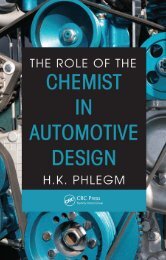Lightweight Electric/Hybrid Vehicle Design
Lightweight Electric/Hybrid Vehicle Design
Lightweight Electric/Hybrid Vehicle Design
Create successful ePaper yourself
Turn your PDF publications into a flip-book with our unique Google optimized e-Paper software.
xxiv <strong>Lightweight</strong> <strong>Electric</strong>/<strong>Hybrid</strong> <strong>Vehicle</strong> <strong>Design</strong><br />
0.4 <strong>Electric</strong>-drive fundamentals<br />
While battery-electric vehicles were almost as common as IC-engined ones, at the beginnings of<br />
the commercialization of the powered road vehicle, it was not until the interwar years that serious<br />
studies were taken into operating efficiency of such systems, as a precursor to their introduction in<br />
industrial trucks and special purpose vehicles such as milk floats. Figure 0.4 illustrates some of<br />
the fundamental EV traction considerations as the technology developed. For the Mercedes<br />
Electromobile of the early 1920s, for example, seen at (a), more sophisticated wheel drives were<br />
introduced, with motors formed in the wheels to eliminate transmission gear losses. An energy<br />
diagram for this drive is seen at (b). The basic definitions and relationships of electromagnetism<br />
are helpful in the appreciation of the efficiency factors involved.<br />
0.4.1 ELECTROMAGNETIC BASICS<br />
While the familiar magnetic line-of-force gives the direction of magnetic force at any point, its<br />
field strength H is the force in dynes which would act on a unit pole when placed in the field. For<br />
magnetic material such as soft iron placed in the field, the strength of field, or magnetic intensity<br />
B, inside the iron is greater than H, such that B = μH, where μ is the permeability of the material<br />
(which is unity for non-metallics). When the cross-section of the object, at right angles to the<br />
magnetic field, is denoted by a, the magnetic flux φ is the product Ba in maxwells. Since it is taken<br />
that at unity field strength there is one line of force per square centimetre, then magnetic induction<br />
is measured in lines per cm 2 and flux is often spoken of as in ‘lines’.<br />
Faraday’s law defined the induced EMF as rate of change of flux (-dφ/dt×10 -8 volts) and Lenz’s<br />
law defined the direction of the induced EMF as such that the current set up by it tends to stop the<br />
motion producing it. The field strength of windings having length l, with N turns, carrying current<br />
I is<br />
H = 4πIN/10l which can be rearranged as φ(l/ma) = 4πIN/10<br />
where the flux corresponds to the current in an electrical circuit and the resistance in the magnetic<br />
circuit becomes the reluctance, the term on the right of the equation being the magneto-motive<br />
force. However, while in an electric circuit energy is expended as long as the current flows, in a<br />
magnetic circuit energy is expended only in creating the flux, not maintaining it. And while electrical<br />
resistance is independent of current strength, magnetic permeability is not independent of total<br />
flux. If H is increased from zero to a high value, and B plotted against H for a magnetic material,<br />
the relationship is initially linear but then falls off so there is very little increase in B for a large<br />
increase in H. Here the material is said to be saturated. When H is reduced from its high value a<br />
new BH curve lies above the original curve and when H is zero again the value of B is termed the<br />
retentivity. Likewise when H is increased in the negative direction, its value when B is zero again<br />
is the coercive force and as the procedure is repeated, (c), the familiar hysteresis loop is obtained.<br />
In generating current electromagnetically, coils are rotated between the poles of a magnet, (d),<br />
and the current depends on both the strength of the magnetic field and the rate at which the coils<br />
rotate. Either AC or DC is obtained from the armature rotor on which the coils are mounted,<br />
depending on the arrangement of the slip-ring commutator. A greater number of coils, wound<br />
around an iron core, reduces DC current fluctuation. The magnetic field is produced by a number<br />
of poles projecting inwards from the circular yoke of the electromagnet. Laminated armature<br />
cores are used to prevent loss of energy by induced eddy currents. Armature coils may be lapwound,<br />
with their ends connected to adjacent commutator segments, or wave-wound (series) when<br />
their ends are connected to segments diametrically opposite one another. The total EMF produced







